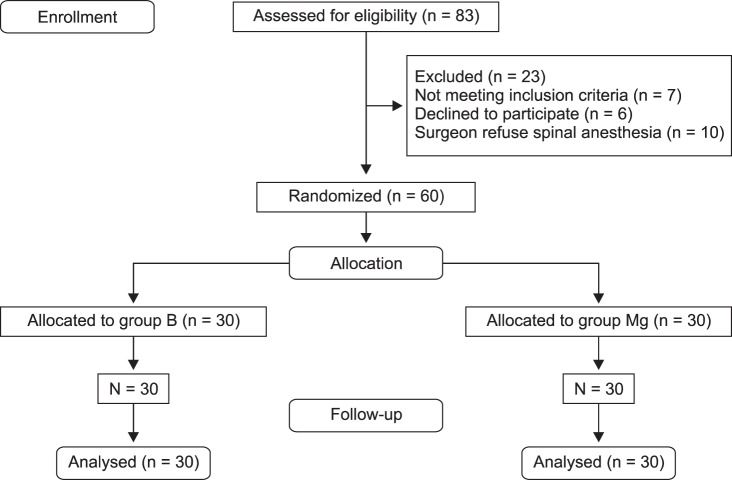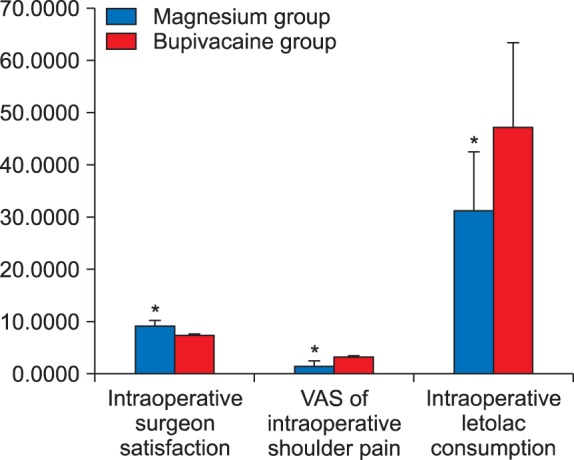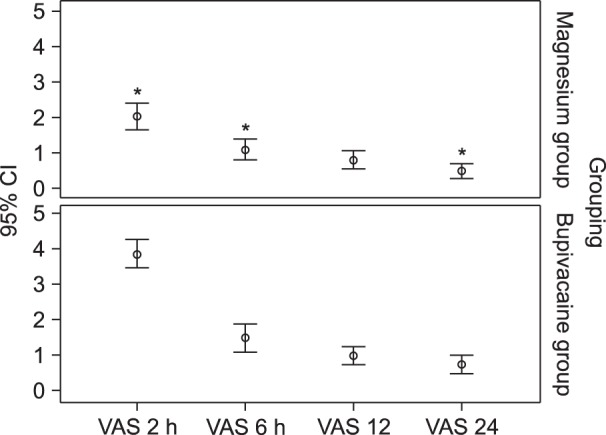Korean J Pain.
2017 Jul;30(3):207-213. 10.3344/kjp.2017.30.3.207.
The impact of magnesium sulfate as adjuvant to intrathecal bupivacaine on intra-operative surgeon satisfaction and postoperative analgesia during laparoscopic gynecological surgery: randomized clinical study
- Affiliations
-
- 1Department of Anesthesia, College of Medicine, Assiut University, Assiut, Egypt. sayed_k_72@yahoo.com
- 2Department of Gynecology and Obstetric, College of Medicine, Assiut University, Assiut, Egypt.
- KMID: 2385353
- DOI: http://doi.org/10.3344/kjp.2017.30.3.207
Abstract
- BACKGROUND
Surgeon satisfaction and patient analgesia during the procedure of laparoscopic surgery are important issues. The aim of this work was to study if an intrathecal (IT) Bupivacaine combined with Magnesium sulfate may or may not provide good surgeon satisfaction in addition to improvement of intraoperative and postoperative analgesia.
METHODS
Sixty female patients were enrolled in this prospective, randomized, double-blind controlled clinical trial study. All patients were operated for gynecological laparoscopic surgery under spinal anesthesia. Patients were divided into two groups (Bupivacaine and Magnesium). Group Bupivacaine (30 patients) received intrathecal Bupivacaine 0.5% only (15 mg), while 30 patients in group Magnesium received intrathecal Bupivacaine (15 mg) in addition to intrathecal Magnesium sulfate (50 mg). The sensory block level, the intensity of motor block, the surgeon satisfaction, the intraoperative visual analog scale (VAS) for pain assessment, the postoperative VAS, and side effects were recorded during the intraoperative period and within the first 24 hours after surgery in the post-anesthesia care unit.
RESULTS
Surgeon satisfaction, intraoperative shoulder pain, postoperative pain after 2 h, and perioperative analgesic consumption (ketorolac) were significant better in group Magnesium than in group Bupivacaine. (P < 0.05). The onset of motor and sensory blocks was significant longer in group Magnesium than the other one. The incidence of PONV, pruritus and urinary retention was insignificant statistically between both groups.
CONCLUSIONS
Magnesium sulfate if used intrathecally as an adjuvant to Bupivacaine would provide a better surgeon satisfaction and would improve the analgesic effect of spinal anesthesia used for gynecological laparoscopic surgery.
MeSH Terms
-
Analgesia*
Anesthesia, Spinal
Bupivacaine*
Clinical Study*
Female
Gynecologic Surgical Procedures*
Humans
Incidence
Intraoperative Period
Laparoscopy
Magnesium Sulfate*
Magnesium*
Pain Measurement
Pain, Postoperative
Postoperative Nausea and Vomiting
Prospective Studies
Pruritus
Shoulder Pain
Urinary Retention
Visual Analog Scale
Bupivacaine
Magnesium
Magnesium Sulfate
Figure
Reference
-
1. Sinha R, Gurwara AK, Gupta SC. Laparoscopic surgery using spinal anesthesia. JSLS. 2008; 12:133–138. PMID: 18435884.2. Hamad MA, El-Khattary OA. Laparoscopic cholecystectomy under spinal anesthesia with nitrous oxide pneumoperitoneum: a feasibility study. Surg Endosc. 2003; 17:1426–1428. PMID: 12802665.
Article3. Gerges FJ, Kanazi GE, Jabbour-Khoury SI. Anesthesia for laparoscopy: a review. J Clin Anesth. 2006; 18:67–78. PMID: 16517337.
Article4. Murphy AA, Nager CW, Wujek JJ, Kettel LM, Torp VA, Chin HG. Operative laparoscopy versus laparotomy for the management of ectopic pregnancy: a prospective trial. Fertil Steril. 1992; 57:1180–1185. PMID: 1534771.
Article5. Minai H, Yamada K, Tashiro K, Yamamoto K. Anesthetic management for awake laparoscopic surgery for ectopic pregnancy in a patient with heterotopic pregnancy. Masui. 2005; 54:1313–1314. PMID: 16296379.6. Lennox PH, Vaghadia H, Henderson C, Martin L, Mitchell GW. Small-dose selective spinal anesthesia for short-duration outpatient laparoscopy: recovery characteristics compared with desflurane anesthesia. Anesth Analg. 2002; 94:346–350. PMID: 11812696.
Article7. Pascual-Ramírez J, Gil-Trujillo S, Alcantarilla C. Intrathecal magnesium as analgesic adjuvant for spinal anesthesia: a meta-analysis of randomized trials. Minerva Anestesiol. 2013; 79:667–678. PMID: 23722295.8. Staehr-Rye AK, Rasmussen LS, Rosenberg J, Juul P, Lindekaer AL, Riber C, et al. Surgical space conditions during low-pressure laparoscopic cholecystectomy with deep versus moderate neuromuscular blockade: a randomized clinical study. Anesth Analg. 2014; 119:1084–1092. PMID: 24977638.
Article9. Faiz SH, Rahimzadeh P, Sakhaei M, Imani F, Derakhshan P. Anesthetic effects of adding intrathecal neostigmine or magnesium sulphate to bupivacaine in patients under lower extremities surgeries. J Res Med Sci. 2012; 17:918–922. PMID: 23825989.10. Ozalevli M, Cetin TO, Unlugenc H, Guler T, Isik G. The effect of adding intrathecal magnesium sulphate to bupivacaine-fentanyl spinal anaesthesia. Acta Anaesthesiol Scand. 2005; 49:1514–1519. PMID: 16223399.
Article11. Shoeibi G, Sadegi M, Firozian A, Tabassomi F. The additional effect of magnesium sulfate to lidocaine in spinal anesthesia for cesarean section. Int J Pharmacol. 2007; 3:425–427.
Article12. Arcioni R, Palmisani S, Tigano S, Santorsola C, Sauli V, Romanò S, et al. Combined intrathecal and epidural magnesium sulfate supplementation of spinal anesthesia to reduce post-operative analgesic requirements: a prospective, randomized, double-blind, controlled trial in patients undergoing major orthopedic surgery. Acta Anaesthesiol Scand. 2007; 51:482–489. PMID: 17378788.
Article13. Ghrab BE, Maatoug M, Kallel N, Khemakhem K, Chaari M, Kolsi K, et al. Does combination of intrathecal magnesium sulfate and morphine improve postcaesarean section analgesia? Ann Fr Anesth Reanim. 2009; 28:454–459. PMID: 19427159.14. Unlugenc H, Ozalevli M, Gunduz M, Gunasti S, Urunsak IF, Guler T, et al. Comparison of intrathecal magnesium, fentanyl, or placebo combined with bupivacaine 0.5% for parturients undergoing elective cesarean delivery. Acta Anaesthesiol Scand. 2009; 53:346–353. PMID: 19173689.
Article15. Shariat Moharari R, Motalebi M, Najafi A, Zamani MM, Imani F, Etezadi F, et al. Magnesium can decrease postoperative physiological ileus and postoperative pain in major non laparoscopic gastrointestinal surgeries: a randomized controlled trial. Anesth Pain Med. 2013; 4:e12750. PMID: 24660146.
Article16. Buvanendran A, McCarthy RJ, Kroin JS, Leong W, Perry P, Tuman KJ. Intrathecal magnesium prolongs fentanyl analgesia: a prospective, randomized, controlled trial. Anesth Analg. 2002; 95:661–666. PMID: 12198056.
Article17. Banihashem N, Hasannasab B, Esmaeili A, Hasannasab B. Addition of intrathecal magnesium sulfate to bupivacaine for spinal anesthesia in cesarean section. Anesth Pain Med. 2015; 5:e22798. PMID: 26161320.
Article18. Morrison AP, Hunter JM, Halpern SH, Banerjee A. Effect of intrathecal magnesium in the presence or absence of local anaesthetic with and without lipophilic opioids: a systematic review and meta-analysis. Br J Anaesth. 2013; 110:702–712. PMID: 23533255.
Article19. Woolf CJ, Thompson SW. The induction and maintenance of central sensitization is dependent on N-methyl-D-aspartic acid receptor activation; implications for the treatment of post-injury pain hypersensitivity states. Pain. 1991; 44:293–299. PMID: 1828878.
Article20. Ascher P, Nowak L. Electrophysiological studies of NMDA receptors. Trends Neurosci. 1987; 10:284–288.
Article21. Woolf CJ, Chong MS. Preemptive analgesia--treating postoperative pain by preventing the establishment of central sensitization. Anesth Analg. 1993; 77:362–379. PMID: 8346839.
Article
- Full Text Links
- Actions
-
Cited
- CITED
-
- Close
- Share
- Similar articles
-
- Comparison of intrathecal versus intra-articular dexmedetomidine as an adjuvant to bupivacaine on postoperative pain following knee arthroscopy: a randomized clinical trial
- Magnesium: a versatile drug for anesthesiologists
- Pain alleviation in patients undergoing cardiac surgery; presternal local anesthetic and magnesium infiltration versus conventional intravenous analgesia: a randomized double-blind study
- The Analgesic Effect of Single Dose of Intrathecal Magnesium Sulfate
- Intrathecal injection of magnesium sulfate: shivering prevention during cesarean section: a randomized, double-blinded, controlled study




